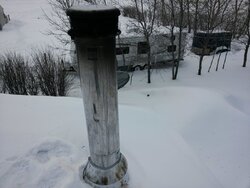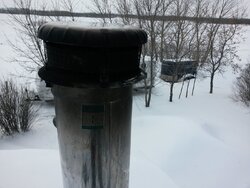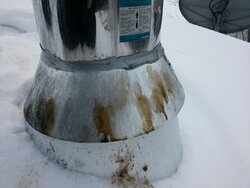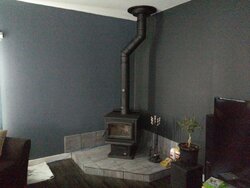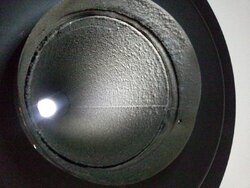Hello. This is my first year of burning and I was outside moving snow today, looked up at my flue and noticed some brown gunk on the side of it. I attached some pics for you all to see. What is this? I stopped burning for now until I figure out what the problem is. Is it creosote? The main pipe in my living room sounds hollow when I tap it so I guess that means is empty? I have attacked pics of the stove in my living room. There is only about 6 feet of stove pipe coming out the roof
First year burner with question
- Thread starter Mikewelland
- Start date
-
Active since 1995, Hearth.com is THE place on the internet for free information and advice about wood stoves, pellet stoves and other energy saving equipment.
We strive to provide opinions, articles, discussions and history related to Hearth Products and in a more general sense, energy issues.
We promote the EFFICIENT, RESPONSIBLE, CLEAN and SAFE use of all fuels, whether renewable or fossil.
You are using an out of date browser. It may not display this or other websites correctly.
You should upgrade or use an alternative browser.
You should upgrade or use an alternative browser.
- Status
- Not open for further replies.
jatoxico
Minister of Fire
Creocicles, nice!
Can come from;
Burning in very cold and wet weather so cap gets very cool and causes creosote.
Moisture in wood (even recommended 20% moisture wood has water) forms dirty icicles on very cold cap.
Burning less than ideal (green) wood or too much smoldering of the load by shutting air too much.
Can be 1 or combo of all. From your pictures that looks like it's time for a mid-season cleaning. How much and what kind of wood has been through the unit and when was that wood cut, split and stacked (CSS)? Hardwoods take about 2 yrs to season to 20%.
Can come from;
Burning in very cold and wet weather so cap gets very cool and causes creosote.
Moisture in wood (even recommended 20% moisture wood has water) forms dirty icicles on very cold cap.
Burning less than ideal (green) wood or too much smoldering of the load by shutting air too much.
Can be 1 or combo of all. From your pictures that looks like it's time for a mid-season cleaning. How much and what kind of wood has been through the unit and when was that wood cut, split and stacked (CSS)? Hardwoods take about 2 yrs to season to 20%.
Poindexter
Minister of Fire
I think jatoxico pretty well nailed it.
Time to clean the inside of the pipe for sure to see what else is in there.
The outside stuff, to me indicates the very top of the chimney was cool enough for water to condense and glom onto smoke particles as it was condensing. Time to figure out how much of that is/was happening inside the chimney pipe as well.
Might be just run the stove hotter on those really cold nights, might be slightly too damp wood night after night after night.
I do encourage you to get it swept sooner rather than later, careful inspection of the sweepings might tell us a lot about how the pipe got to there.
Time to clean the inside of the pipe for sure to see what else is in there.
The outside stuff, to me indicates the very top of the chimney was cool enough for water to condense and glom onto smoke particles as it was condensing. Time to figure out how much of that is/was happening inside the chimney pipe as well.
Might be just run the stove hotter on those really cold nights, might be slightly too damp wood night after night after night.
I do encourage you to get it swept sooner rather than later, careful inspection of the sweepings might tell us a lot about how the pipe got to there.
Seanm
Minister of Fire
Looks like the same stove as me (you should add your stove to your sig). I'm on my third season with mine and haven't seen what I see in your pictures. My neighbor across the street has it often (hes also had chimney fires so I suspect his wood). On occasion in very cold weather I will get a few icicles but that's it. I'm not sure how much of a difference it makes but I dont have the screen that you do just a rain cap of sorts. With my stove I found the cleanest part of the flu was the section inside the house that usually consists of only fly ash and the most creo I get is near the top where its the coolest so tapping the inside wont tell you the whole story. I wont repeat what jatoxico above says but I agree with his points and also that its time for a clean out. Tell us about your wood.
Where I live I can only get poplar wood. I know it's not the best kind of wood but there is so much of it here. I have a cord of birtch that I have to cut up and try. I have a oil heater so I only run the stove when I am home. I got it December 1st and only burn from around 6pm to around 9pm or so on weekdays and all day through the weekend. So not really burning as much as everyone else. I live on an acreage so all the wood I get is just dead fall that had been laying around. We have about 4 feet of snow right now and all my wood is stacked outside. So I tend to cut a bunch and bring it inside to dry for a day or two before using it. Should I stop burning in it until I clean it or is it just what jatoxico says. ......creocicles?
My flue temp stays around that 500 to 600 degree mark when burning. And seanm, I have a PE super 27 wood burning stove
Seanm
Minister of Fire
Is that a magnetic thermometer I see? I had one in the beginning but gave it up for an IR (personal preference only). I was checking my temps last night and had a stove top temp of 650 F and a temperature on the outside of my double wall pipe was reading 380 F. I would get yourself a moisture meter and after warming up a round inside, split it and check the inside face (never the ends) of the split to see what you get. You will want it below 20% moisture content. You should be able to get one under $30. Ive burned a bit of poplar here to and although it burns up fast it can throw some great heat. I remember picking a big split out of my stacks year before last and feeling how lite it was and thought it was ready to burn. I decided to split it open and test it and found I was way off. Is that Birch for next year? Split it now and get it top covered and it might be ready.My flue temp stays around that 500 to 600 degree mark when burning. And seanm, I have a PE super 27 wood burning stove
Nope. Is a probe thermometer that I have. I will pick up a moisture next time I am in the city hah. I live about an hour and a half from any walmart or any other stores. I don't have a chimney brush yet so I will pick one of those up as well
jatoxico
Minister of Fire
Should I stop burning in it until I clean it or is it just what jatoxico says. ......creocicles?
Only you can say if it's too bad to keep burning but you probably can. Keep your eye on it and clean ASAP. You do most likely just have to adjust some of your practices. The creocicles
 are a combo of melting snow on cap and wet wood. Try to split down some of what you have to smaller pieces and give more air by leaving the air control open a bit more and stacking loose. Any source of dry scrap like pallets or lumber scrap? That always helps marginal wood. Since you're not trying to burn overnight or while you're out of the house you can feed smaller splits to keep the fire going.
are a combo of melting snow on cap and wet wood. Try to split down some of what you have to smaller pieces and give more air by leaving the air control open a bit more and stacking loose. Any source of dry scrap like pallets or lumber scrap? That always helps marginal wood. Since you're not trying to burn overnight or while you're out of the house you can feed smaller splits to keep the fire going.There is a product called a Soot-Eater that you can use to clean the flue from the bottom up (do a search) if your roof is treacherous. A moisture meter as suggested is a good thing to have when your trying to figure things out.
Really just want to point out that although you're prob OK now it does look like you need to make a few changes so you can burn cleaner and create less creosote in the first place. Burn hot, as often as possible not just occasionally. Long term work on having a supply of dry wood. With 20% wood (roughly 2 yr CSS) you will not believe the difference in your stove heat wise, ease of use and for keeping the flue clean.
saskwoodburner
Feeling the Heat
Where I live I can only get poplar wood. I know it's not the best kind of wood but there is so much of it here.
I live on an acreage so all the wood I get is just dead fall that had been laying around. We have about 4 feet of snow right now and all my wood is stacked outside. So I tend to cut a bunch and bring it inside to dry for a day or two before using it.
I'm not sure where abouts in Sask you are, but I'm near Prince Albert, and those nice days in January really were a pain in the butt for the dead fall (my only complaint). Get a little skift of snow laying on the logs, and then it melts, freezes, and melts again. Not enough to keep me from burning it, but needing to let it dry inside for a day or two. Previous to that, let it warm up to room temp and it was good to burn!
xman23
Minister of Fire
Looks normal for first year burning. Not the greatest wood and burning techniques. I'd guess your blacking the glass. It might be no more than a gooey cap. If you haven't plugged the screen yet it's not bad. It took me three years with mine looking like that, and now the same setup does non of that.
husky345 vermont resolute
Feeling the Heat
U need to cut early in the year split, stack , pile your wood off the ground ie on skids then I like to top cover with steel roofing then it should sit for several months preferably were it gets sun and wind. It's ideal to keep a year ahead so you know for sure your wood is dry. 20% moisture or lower is perfect
Well I went out and purchased a moisture meter and tested some of the wood inside as soon as I got home. It ranged anywhere from 15 to 25 percent. Am I not burning hot enough then? My flue temp hovers between 400 and 600 with my probe thermometer. Its in the "safe zone" according to the thermometer. I do not have a stove top one yet. Maybe I should get one
jatoxico
Minister of Fire
Mike did you test the face of a fresh split? Otherwise you'll get a false reading, must be a fresh split that's close to room temp. If so then 25% is pushing it a bit but should be fair. Would need more air most though. Gotta be specific w/ flue thermos. Is it single wall or double, is the thermo intended for that use on a flue or stove pipe etc?
One easy thing to see how you're burning is to simply go outside and check for smoke. If you see smoke (not steam) add air. Water in the wood (even good wood) will give off steam which will dissipate within a few feet of the stack. If it's blue grey and reaching the neighbors it's smoke.
it's smoke.
One easy thing to see how you're burning is to simply go outside and check for smoke. If you see smoke (not steam) add air. Water in the wood (even good wood) will give off steam which will dissipate within a few feet of the stack. If it's blue grey and reaching the neighbors
 it's smoke.
it's smoke.Seanm
Minister of Fire
15% is great but 25% should be thrown back into the stacks until next year. I've burned a little bit of larch in the past that was close to 25% and the stove did not like it one bit (we have the same stove). I will have to leave others who are more knowledgeable to answer the flu question as I've only read with my IR on the outside of my double wall and that method is no where near accurate.Well I went out and purchased a moisture meter and tested some of the wood inside as soon as I got home. It ranged anywhere from 15 to 25 percent
This is good advice and will work until you get a stove top thermometer and can contradict the thermometer. Ive had it a few times where Ive gotten up to temps but then go outside to check and found it smoking more than I like and then came in and turned up the air a bit like jatoxico suggests . As you can probably tell I like the IR and use it for my stove top temps, flu, walls, snow, dogs tummy etc. You are supposed to find the hottest spot on the surface to measure your temps and Ive found on our stoves it is right around the collar where it enters the flu. I was cruising last night around 650 f. I would get your self a soot eater scrubber or some ridged poles and a poly brush and take the half hour and scrub it before trying to reach higher temperatures.One easy thing to see how you're burning is to simply go outside and check for smoke. If you see smoke (not steam) add air.
kennyp2339
Minister of Fire
husky345 vermont resolute
Feeling the Heat
Typ0
Feeling the Heat
I saw some of that brown crap in the snow on my roof around my pipe when I was out shoveling yesterday. The weather has been been horrible here extreme cold and massive blowing winds. I figure the exposed part of my chimney struggles to stay anywhere above freezing temps and the snow is blowing all around my cap .... end result is when I burn at the hottest temp of the cycle the cap defrosts ice and crap on it that has been discolored and it drips.
jatoxico
Minister of Fire
Good job getting out there and sweeping. Doesn't look bad to me either but you don't know until you check it. From the looks of it the cap was ready to clog which would have put you out of business no matter what the pipe looks like so it wasn't a waste of time. Maybe you can find a cap that can tolerate your conditions better. Can't tell from here if it was a wind issue or snow on the cap itself or just too restrictive.
If you can get all your wood around 20% the problem may go away by itself. Has been a tough winter, here anyway.
If you can get all your wood around 20% the problem may go away by itself. Has been a tough winter, here anyway.
- Status
- Not open for further replies.
Similar threads
- Replies
- 21
- Views
- 496
- Replies
- 25
- Views
- 867
- Replies
- 16
- Views
- 756
- Replies
- 13
- Views
- 738


